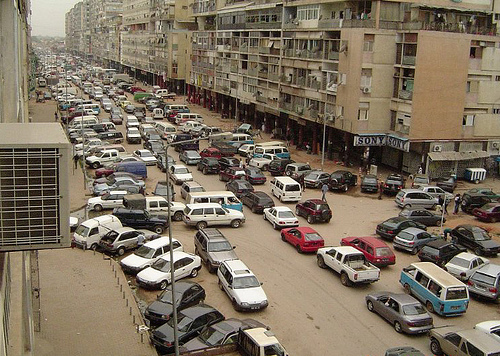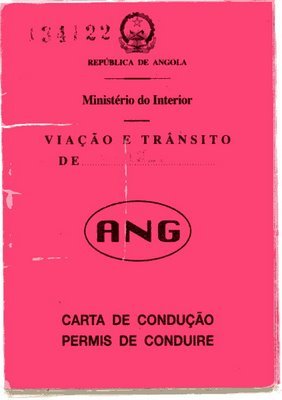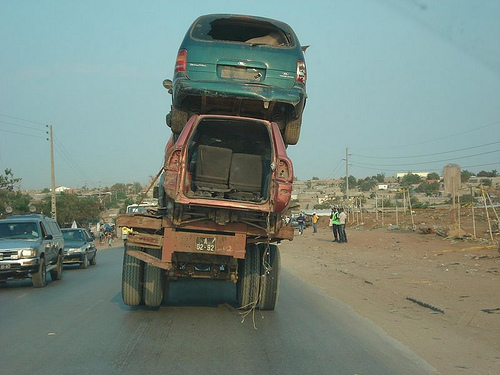The new Angolan highway code [2] [pt], which came into effect on April 1, has divided society. On one hand, the new code is seen as a good measure taken by the Government as it will educate some of the drivers who are less attached to life. Nevertheless, the legislation contains costs that not everyone is able to meet. The compulsory use of seats for children under twelve, may be an example. There are now well informed thieves who have begun stealing these items each of which costs around 30 thousand Cuanza (approximately 385 USD at the date this piece was published).
Among other measures, the new highway code imposes the use of seat belts and child seats as well as dictating the mandatory use of helmets for motorcycle drivers. Fines applied tend to be heavy. However, most drivers choose to ignore the law. This fact, coupled with the country's poor road conditions, is causing congestion and situations of risk for those using public roads. Some say that when you learn how to drive in Angola, then you can drive anywhere.
For the more demoniac drivers, who offer taxi services, the new highway code has triggered great pain, since most run without legal documentation and without normal security measures, such as excess passengers. For one month, the transit police has exercised its regulatory function in an educational environment, thereby enabling, persuading and educating people about the new behavior they are expected to assume while on the road.
Eugénio Costa Almeida from blog Pululu [1] [pt] presents the following analysis of the new highway code and his reaction:
“Uma das alterações, e talvez a mais importante para quem está na Diáspora, deve-se ao facto dos novos documentos de licença de condução serem válidos em qualquer parte do mundo dado que o mesmo se adequa às convenções internacionais adoptadas no âmbito das Nações Unidas. Acaba-se, de vez, assim o esperamos, o “Caso Mantorras (nota autora: que causou mau estar nas relações diplomáticas entre Angola e Portugal, em relação à utilização das cartas de condução portuguesas em solo angolano, após o jogador do Benfica ter sido apanhado a conduzir em Portugal com a carta caducada).
A outras das significativas alterações e que Luanda já hoje sentiu, com a reduzida presença deles, prende-se com as novas normas que limitam a circulação de alguns taxistas dos “azuis e brancos” mais conhecidos por “candongueiros”. Entre as restrições a obrigatoriedade de uso de cintos de segurança em todos os bancos, embora, segundo pareça e a fazer fé em certos relatos de Luanda, a polícia ainda está só a exigir – o que se admite durante um período de adaptação – nos bancos da frente, a apresentação de uma licença de circulação legalizada – consta-se que a maioria não estava encartado – ter licença de aluguer e que as viaturas se mostrem estar técnica e legalmente adaptadas ao referido uso, além de não poderem transportar pessoas em veículos de transporte de mercadorias.”
The same blogger continues, drawing attention to the need to improve the roads and the amount of public transport available to Angolan citizens.
“Vamos ver se Angola não segue as “normas” de um outro reconhecido país que tem restrições a certos “modos” no código mas que se esquece, em muitos casos, de melhorar as condições das estradas. Porque se estradas condignas não há códigos, por muito bons e penalizadores que sejam, que se safem. Já agora talvez seja o momento ideal para Luanda e arredores sejam dotados de melhores transportes colectivos municipais e que liguem com uma curta periodicidade exigível os diferentes bairros e municípios da capital obrigando as três actuais empresas de transporte se auto-regularem e auto-disciplinarem entre si.
Talvez que assim o fluxo rodoviário, nomeadamente em Luanda e arredores, fosse menor e mais fluido. Talvez assim as pessoas pudessem chegar mais depressa aos seus empregos e, ou, às suas casas. Talvez que assim houvesse menor perca de tempo e maior rentabilidade nos serviços e nas empresas; talvez, talvez, talvez…
Cabe ao Governo Provincial cogitar e ponderar bem no assunto!”
It is the job of the Provincial Government to think and consider this matter!
For more information visit the website AngolaBela [5] [pt] where a series of questions and answers related to this subject can be found.
 [6]
[6]A traffic jam in Luanda. Photo uploaded on June 23, 2008 by Flickr user, azeite, with a Creative Commons License
Originally written in Portuguese, translation into English by Sara Moreira [7].

